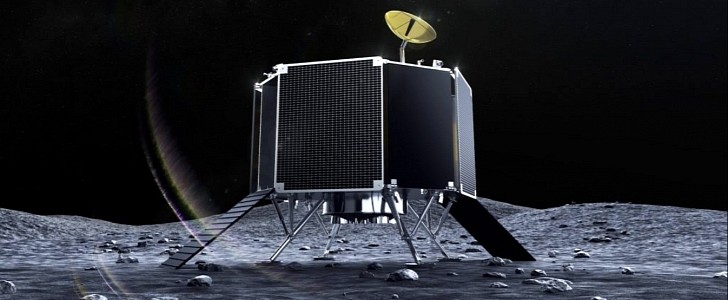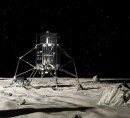Japanese startup ispace has unveiled the Series 2, a next-generation lunar lander, which the company plans to first use for its third lunar mission targeted for 2024. The model is not only larger than ispace's first-generation lander model but it is also designed to survive the cold nights on the dark side of the Moon.
Unveiled at the 36th Space Symposium in Colorado Springs, Series 2 is the largest lander ispace has ever designed, towering at around 9 ft tall and 14 ft wide (approx. 2.7 m tall by 4.2 m wide), including its legs.
The lander previously passed a preliminary design review (PDR) in June, which is an important stage in the vehicle's development. The next step will be its development in collaboration with General Atomics and Draper in the future, making up a team with decades of experience in space exploration. Ispace says that the lander will be designed, manufactured, and launched in the U.S.
As for mission, Series 2 will transport payloads to both lunar orbit and the lunar surface, being able to carry up to 500 kg (1,102 lbs). Its capacity can be substituted for missions whose payloads are solely for lunar orbit, so it would be capable of transporting 2,000 kilograms (4,409 lbs) to lunar orbit. This modular payload design with multiple payload bays allows for flexibility and optimization for a wider range of government, commercial and scientific customers.
Ispace built the lander in order to be capable of surviving the lunar night (scientists estimate that temperatures can even drop to -298 degrees Fahrenheit/ -183 degrees Celsius). Not only that but Series 3 is also designed to be able to land on the far side of the Moon and polar regions.
In addition, the lander's Guidance, Navigation, and Control (GNC) system contain precision landing technologies such as surface relative velocimetry and hazard avoidance, which enable high-precision obstacle avoidance and pinpoint landing site targeting during descent.
Series 2 is intended to provide a reliable solution for a wide range of missions, including future missions, under NASA's Commercial Lunar Payload Services (CLPS) program. The lander will be equipped with five pressure-fed main engines and 12 reaction control thrusters, all of which are designed to maintain proper orientation throughout the missions.
The lander previously passed a preliminary design review (PDR) in June, which is an important stage in the vehicle's development. The next step will be its development in collaboration with General Atomics and Draper in the future, making up a team with decades of experience in space exploration. Ispace says that the lander will be designed, manufactured, and launched in the U.S.
As for mission, Series 2 will transport payloads to both lunar orbit and the lunar surface, being able to carry up to 500 kg (1,102 lbs). Its capacity can be substituted for missions whose payloads are solely for lunar orbit, so it would be capable of transporting 2,000 kilograms (4,409 lbs) to lunar orbit. This modular payload design with multiple payload bays allows for flexibility and optimization for a wider range of government, commercial and scientific customers.
Ispace built the lander in order to be capable of surviving the lunar night (scientists estimate that temperatures can even drop to -298 degrees Fahrenheit/ -183 degrees Celsius). Not only that but Series 3 is also designed to be able to land on the far side of the Moon and polar regions.
In addition, the lander's Guidance, Navigation, and Control (GNC) system contain precision landing technologies such as surface relative velocimetry and hazard avoidance, which enable high-precision obstacle avoidance and pinpoint landing site targeting during descent.
Series 2 is intended to provide a reliable solution for a wide range of missions, including future missions, under NASA's Commercial Lunar Payload Services (CLPS) program. The lander will be equipped with five pressure-fed main engines and 12 reaction control thrusters, all of which are designed to maintain proper orientation throughout the missions.






